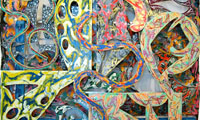 'Totally Rad': The Irony and Agony of the '80s Art Scene
'Totally Rad': The Irony and Agony of the '80s Art SceneBy JOHN GOODRICH | July 31, 2008
In midsummer, when many galleries wrap up the season with group shows, Paul Kasmin Gallery is adding a welcome twist to an old routine. "Totally Rad" combines works by several gallery artists with significant additional paintings, sculptures, and photographs to offer a plangent sampling of New York art from the "go-go 80s."
The decade of the 1980s saw the resurgence of painting and conceptual art under hyphenated labels ("Neo-Expressionism," "Neo-Conceptualism," "Neo-Geo") that reflected the borrowings of the styles, if not necessarily the earnestness, of earlier art. The political urgency of much '70s art had given way to expressions ranging from ironic remove to ebullient appropriation. Just as memorable as the art of the '80s was its fevered environment: the onslaught of AIDS, the rise and fall of the East Village art scene (and, in Federal Plaza, of Richard Serra's "Tilted Arc"), the battles over National Endowment for the Arts funding, and, not least, the extraordinary boom and bust of the art market. The skyrocketing prices and careers — and their perceived manipulation by aggressive collectors — left some suspecting that the work satisfied not the mandate of history but a market for glamorous products.
Handsomely installed at Paul Kasmin, these 17 works — many of them large pieces by major artists — are startlingly diverse. Not every work still seems radical. Andy Warhol's large, paint-enhanced silk screen (1986) of a Beatle Boot advertisement seems a bit tame, especially compared to his "Death and Disaster" series from the '60s. While Frank Stella's 10-foot-wide "Talladega" (1980) boasts multiple layers of flamboyantly patterned, curling forms, it feels, ultimately, like a studious homage to Baroque painting.
Works by the younger artists who emerged in the '80s tend to be more indulgent. Using a low camera angle, a stern-looking Tseng Kwong Chi photographed himself standing in a Mao suit before the Statue of Liberty, so that they become parallel towers angling into the light; dated 1979, it presents a wonderfully quirky image of competing propaganda. Julian Schnabel's 12-foot-tall canvas of a building's façade festooned with unidentifiable ornaments (1986) is the very picture of bombastic assurance and indeterminate portent. Cindy Sherman's 6-foot-tall chromogenic print "Untitled (Safe Sex)" (1987) depicts the artist (actually, just her back and leg) seated among a messy assortment of condoms and phallic vegetables. Though colorful, the squalor is less gripping than the sharp-eyed distillation of stereotypes in her "Untitled Film Stills." Mounted next to the Stella, Haim Steinbach's "Charm of Tradition" (1985), a tidy construction with real athletic shoes and a rustic lamp on a Formica-laminated shelf, suggests a semanticist's wistful search for personal order.
Less prepossessing is Jeff Koons's stainless steel statuette of Bob Hope from 1986. Neither a deadpan portrait nor a caricature, this small sculpture seems uncharacteristically tentative for the artist sometimes considered Warhol's heir. David Salle's 1986 canvas layers the images of a man in a captain's hat, an old-fashioned lightbulb, and an outline drawing of a couple in what appears to be a Kama Sutra position. I found its guileful, multiple insinuations less compelling than the adjacent painting by David Wojnarowicz, "Untitled (Alien Mind)" (1984), which with far blunter means and intentions depicts a face hauntingly pocked by a target and fragmentary images of a factory. Works by Jenny Holzer, Peter Halley, Annette Lemieux, Kenny Scharf, Jean-Michel Basquiat, Keith Haring, Robert Longo, and Allan McCollum round out the installation.
The small scope of the exhibition necessarily leaves out a number of influential American artists — there's nothing by Laurie Anderson, Eric Fischl, Sherry Levine, or Robert Gober, for instance, and no installation or video art at all. But the selection on hand vividly summons the high-octane, sardonic energy of the era. It reminds us poignantly, too, of the premature deaths of nearly a third of the artists represented here. A curmudgeon could point out that the work, on the whole, communicates surprisingly little beyond the zeitgeist of its time. Viewed together, the work feels dated — a procession of moments in sanctioned careers. Keith Haring's sculpture titled "Self Portrait" (1989) — a footloose bit of graffiti frozen in aluminum like a corporate logo — summarizes the institutionalizing effect.
What's missing? With the exception of the robust painting by Wojnarowicz, the artists demonstrate only passing interest in pictorial expressions that transcend messages or style. Peter Halley's large red-and-blue canvas addresses the look of abstraction, and adds sly allusions to the technological age, but the painting shows little of the offbeat, internal tensions of Ellsworth Kelly or Al Held, let alone the galvanizing rhythms of Mondrian. Similarly, Messrs. Salle and Schnabel compose proficiently, but only up to the point that allows them to do "their thing," which is suggestive juxtapositions in Mr. Salle's case, and a style of mordant grandeur in Mr. Schnabel's. Greater painters, from Rembrandt to Juan Gris, pursued formal tensions to the last brushstroke, imparting weight to gesture and detail, instead of merely fleshing out in paint. Such failings, of course, are common to a great deal of recent painting, and they surely reflect the choices of the artists as well as the preoccupations of the time, all of which "Totally Rad" commendably places before our eyes. From the vantage point of 2008, we can wonder anew about the value of appropriation and stylistic borrowings, once divorced from art's enduring formal possibilities.
Until September 6 (293 Tenth Ave. at West 27th Street, 212-563-4474).
 'Totally Rad': The Irony and Agony of the '80s Art Scene
'Totally Rad': The Irony and Agony of the '80s Art Scene